Making and Using Flashcards
Rationale
Learn how the character is made, and so make it make sense.
Learning to read and to write Chinese characters is not a matter of
brute force. It is possible to make the learning process much easier by
using a good strategy. The key to the strategy is that Chinese
characters are not random collections of little straight lines. At the
earliest time, many Chinese characters were little line drawings of
things such as the sun, the moon, a horse, a sheep, and so forth. When
students understand the original forms it is easier to understand the
more stylized forms that have evolved from them. It helps, for
instance, to have the idea that the present character for horse, 馬 mǎ,
has an eye, a mane, a back, a tail, and four legs in it. Having at
least that much of an idea of how to write the character will give
students a kind of hook by which they can hold onto the image of the
character or recover it from memory.
It is important to have memory hooks for things to be memorized. It is
almost completely useless to stare at a model character and copy it
over hundreds of times, and it is very useful to use a somewhat vague
memory of the character, write down the best approximation of that
memory, and only then look at a model character. The reason is that
humans memorize things by reproducing them based on some flickering
memory of them, checking the result against a standard, and then
depending on the corrected memory to make another try at reproducing
the thing that is to be learned.
Four-sided flashcards give students alternatives to simply looking at
the answer when one cannot remember how to write a character. One might
look at the Chinese character and then try to recall its pronunciation,
and if one were unable to think of it one might then look at its
meaning to see whether that additional prompt would aid in recalling
the pronunciation Usually it is easier to go from Chinese characters to
English meanings or to Chinese pronunciations than it is to go from the
meaning of some word in English to the pronunciation and writing of it
in Chinese. Here is how the four-sided flashcards can be used:
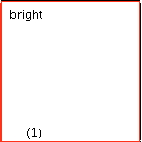
Looking at the first "page" or side of this four-sided card, students
will see the meaning of the character in English. The next task will
typically be to try to remember how to say this word in Chinese. The
student might write down "ming," which is only partly right. Then the
student will open the "book" slightly to take a peek at page 2:

At this point the student should note that the correct way to write the
pronunciation is "míng," not "ming." Tones are important in
Chinese.
The next thing the student will probably do is to try to write the
character. However, the student may not be able to recall how to write
it. So the next step will be to open the "book" and look at page three:
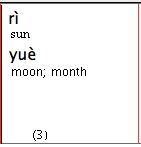
Now the student must depend on having earlier learned how to write the
character for "sun," which is: 日 and the character for "moon," which
is: 月. Even if the student writes these components in the inverse
order, or puts one above the other, doing so is better than simply
looking up the answer. Once the student has written down a response it
is time to look at page four of the four-sided flash card, which shows:
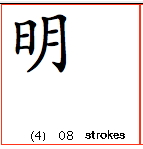
So the total process for learning to write "bright" is to learn to
write日, learn to write 月, and then put them together to write 明. Doing
things this way there is very little likelihood of confusing similar
characters such as 明 and 門.
Do not try to do too much at one time.
Remember that students have to be able to recall at least part of the
desired response in order to be able to improve and consolidate their
memories of the characters they are trying to learn. What would happen
if a student had 100 flashcards, tried to write the first one, failed,
put it at the bottom of the deck of flashcards? That character would
not come up again until an hour or so later, by which time it would
have been completely forgotten again.
The strategy that works best for most students is to work on three to
five flashcards at a time. That way the first character in the deck
come back within a couple of minutes, i.e., while the student still
remembers the previous attempt. After a few groups of three
to five flashcards have been learned the stacks of flashcards can be
made larger because the work will go faster. Also, characters which no
longer pose any challenge can be put aside temporarily to make room for
the ones that are harder to learn.
Folding and Pasting after Printing
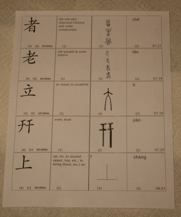
The printed sheet will look like the above sample.
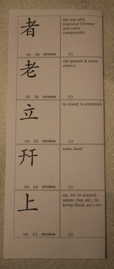
First fold the printed sheet along the center line, and make the
printed side be on the outside.

Fold the sheet one more time, making the English meaning appear on the
outside.
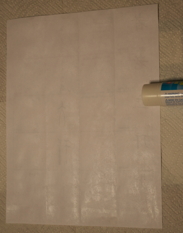
Open the page up flat again, and cover the unprinted side with glue from a
glue
stick.
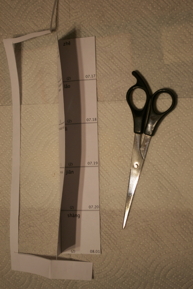
Refold the sheet as you did before. Then trim the outside of the sheet
before cutting the cards apart
horizontally.
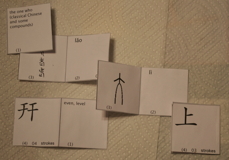
When you cut the cards apart, each sheet will yield five flashcards,
folded as shown.
The adhesive from the glue stick will make the paper into a stiffer
two-ply product that should be more durable and easier to use.









